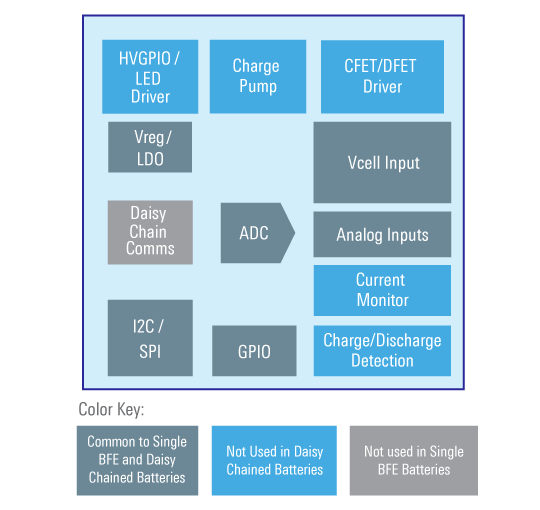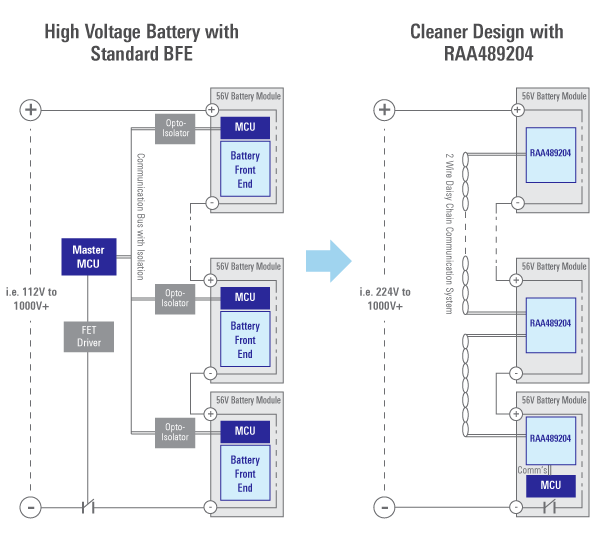Traditionally, battery management ICs are configured to monitor voltages, current and temperatures for all cells in a battery and react to conditions appropriately; for example by turning on or off protection FETs. When the number of series cells exceeds the IC’s cell inputs, another battery IC must be added (daisy-chained) for the additional cells and divided into a separate module.
Most battery management ICs become clunky in a daisy-chained configuration, requiring redundant controllers in each module to complement each battery IC, optocouplers or other costly isolation to aid communication up and down the stack between all the modules. These designs typically include costly, unused silicon on each battery IC for current sense, FET driver, charge pumps, etc., that are not needed in every module of a stacked battery. For instance, current is the same across all the series of cells, and protection FETs will only be added to the top or bottom of the cell stack. Furthermore, the firmware must operate and communicate across each battery module to ensure safety and protection are maintained up and down the stack. See Figure 1 below.

The newly released RAA489204 battery front end IC is designed to efficiently match these high voltage battery requirements without extra ICs, expensive isolation, wasted silicon, or complex firmware for cross-talk needed. Each IC can individually monitor and balance up to 14 cells over a 65V span, but with a two-pin daisy-chainable differential bus, the device is intended for batteries larger than 14 cells. The pins on each RAA489204 are dedicated for differential communication to the next module up (i.e. higher voltage) in the battery stack, and the next module down the battery stack (i.e. lower voltage). See Figure 2 below.

Isolation for these pins can be low cost capacitors or transformers, and maintain a high noise immunity over a long distance. These differential communication stacks follow SPI protocol, both Byte and Block transfer modes, to make them easily compatible with many microcontroller SPI functions. With the ICs managing communication of battery states up and down the stack, only a microcontroller is required, and the firmware needn’t coordinate measurement and response timings with the firmware on another microcontroller to provide all required battery safety and protection functions.
Because it is natively designed for daisy-chained batteries, using the RAA489204 means not just having the exact circuits required but also aligning the built-in communication functions and communication support circuits required to daisy chain batteries in series. Some of these functions and circuits for daisy-chained communication include:
- Cell measurement supports averaging to provide accuracy and eliminate outliers on each outbound data transfer, as well as reduce erroneous fault reactions
- Hardware Reset command support – pull EN pin internally to reset part without adding additional cost
- Multiple options for setup and control
- Multiple internal and external autonomous options for balancing
- Support for up to 30 devices in a stack with a 1 Mbps daisy chain data rate
- Flexible when reading or writing registers, which results in fewer SPI transfer sessions, optimized communication and requires less MCU resources
- Increased memory buffer manages asynchronous SPI transfer (RAA489204 can operate on high daisy chain data speeds with low-performance MCUs without overflowing the master stack device buffer)
Engineers tasked to design high voltage, multi-module batteries should opt for the RAA489204 as the latest and best device available for these applications. Renesas provides not just the parts, but supporting evaluation boards, communication boards, evaluation GUI, and sample code to enable rapid and easy development. Visit the RAA489204 product page for more information.
